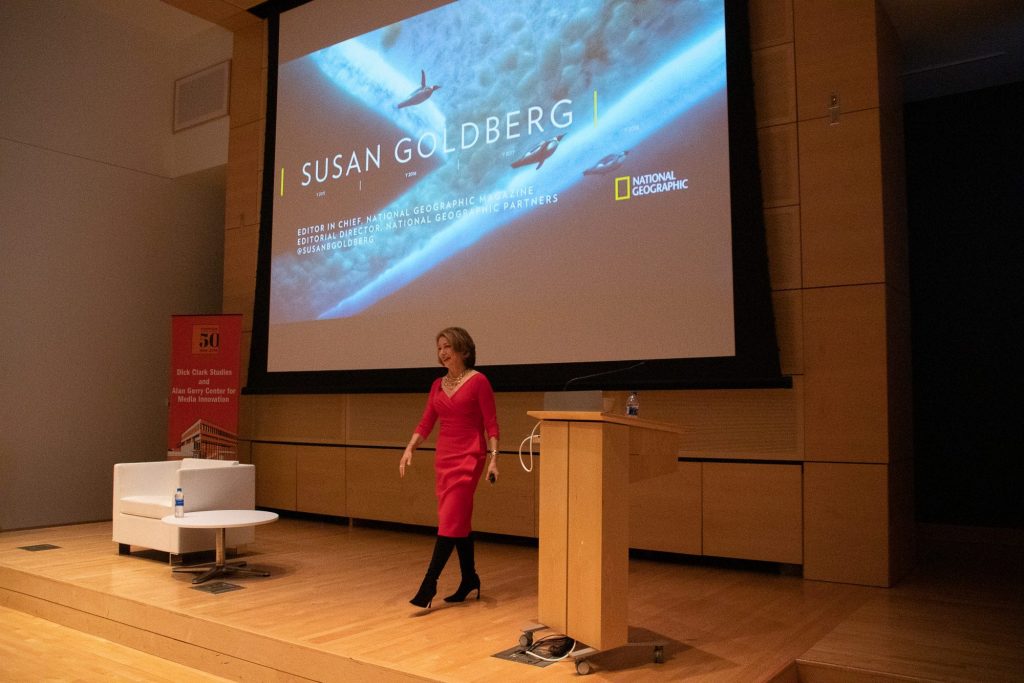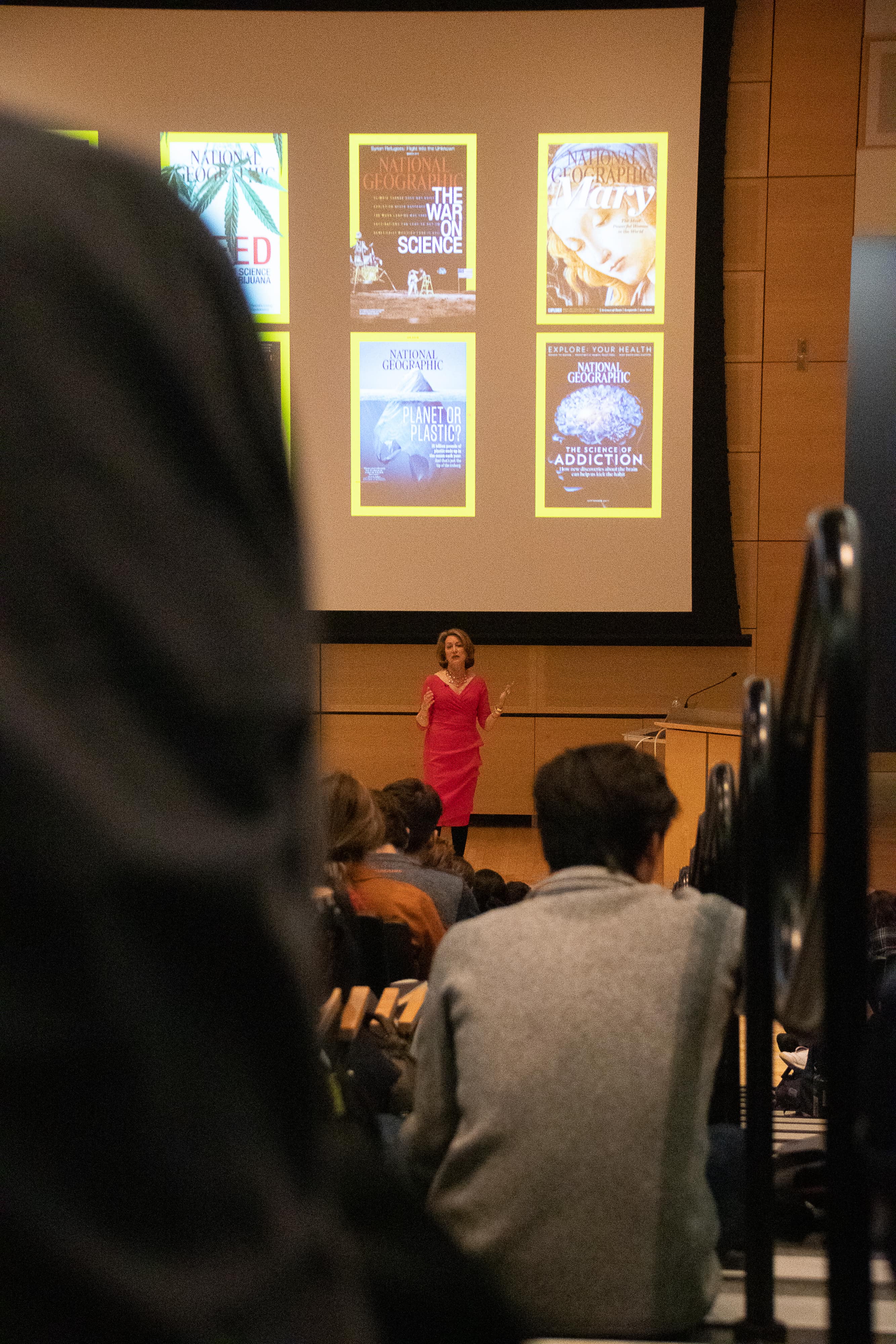National Geographic editor stresses the value of magazine storytelling
Susan Goldberg talks Nat Geo

Susan Goldberg, the editor in chief of National Geographic and the editorial director of National Geographic Partners, visited Syracuse University on Wednesday, April 10 to discuss the direction of the publication, the state of the industry and platform strategy, using the publication’s groundbreaking articles as examples.
“On the side of science, on the side of facts, and on the side of the planet,” National Geographic captivates audiences across the world through its unique storytelling, both written and visual. While speaking to a nearly full room at the Joyce Hergenhan Auditorium, Goldberg detailed the five basic storytelling principles she implemented into the magazine: make a difference, do what others can’t, be a part of the conversation, act urgently and know who you are.
Goldberg sat down with The NewsHouse prior to her lecture to discuss diversity, being a part of the national conversation and the benefits of telling stories in a magazine format.
You are the first female editor in chief of National Geographic, which is a tremendous feat in itself. As editor in chief, whether it is in the staff or the articles, how do you continue a diverse lens in the publication?
One of the things we try to do is keep this discussion really top of mind. We don’t do everything perfectly. We are far more diverse than we used to be, both in terms of the kinds of stories we do, who we have doing the stories, either writers or photographers, and also who we are quoting in the stories. We also know we are not there yet. We are not as diverse as we need to be. To cover a diverse world, you need a really diverse staff and a diverse way of thinking about the world. Sometimes these are uncomfortable internal conversations, but the only way I know to change it is one writer at a time, one photographer at a time, one interview at a time. It is a lot like hiring. You can never get a more diverse staff if you don’t have a diverse pool of applicants. You can’t always go back to the usual suspects. You have to have a diverse pool of people from which you draw your applicants or else it will never move the needle. That is what we try to do and keep it super top of mind. If it is not on the top of my mind every day, my staff helps me remember that, which is great.
Something you really value is making sure the articles are topical and contributing to the national conversation, or at least starting it. With that being so far away, how do you make sure the issues are doing that?
I think there is a few things. One is that we are closing that window quite a bit. More and more, stories will break on one of our digital platforms and then roll up eventually into a print story, because that is the way to be the most timely. That said, it is not that hard to figure out what a national conversation is going to be. For example, we know that 2020 is not only going to be the 100th anniversary of women getting the right to vote. We also know how important the women’s vote will be in the 2020 presidential election because we just saw a lot of evidence of that in 2018 and the power of women’s voices. So you can project this is going to be a huge conversation as we go through this year, and it will especially start picking up towards the end of 2019 and it will go all the way through 2020. Therefore, in November of 2019, we are going to do a special issue dedicated to the power of women’s voices. We have a huge book coming out on the topic, looking at the 130 years of National Geographic archives of how women have been depicted for the last 130 years, and then we are going to launch a series of stories about the state of women all over the world, and those stories will run all through 2020. You might not know the specifics of every conversation, but you can look at the big events that are coming up, or the big anniversaries that are coming up, and figure out how to be topical around that and create content that way.
What advice do you have for young journalists who are trying to be a part of the bigger conversation and follow in those footsteps?
I think one of the great advantages of being a young journalist — well, there are a bunch of advantages. One, you know how to use all the technical tools that the rest of us have had to learn. You just somehow know. You are a digital native. You have a huge advantage over the rest of us. Two, if journalism is about riding the wave of trends and cool new things, you are making those things. You are doing those things. You are creating those trends. What are the topics that you and your friends and your colleagues are talking about? Could those be really great stories to do? Try to take a step back from your own conversations and try to think about what are the big themes here that are so important to younger people today. Those would make fantastic stories.
It is a funny thing about newsrooms. When I was coming up in newsrooms, it was always the grizzled veterans giving advice to young people. Now just as much, it is the younger people giving advice to the older people about “this is how to post on social media,” “this is how to write a story for Snapchat,” “writing for podcasts is very different than long form journalism — let me show you some tricks.” It is so fantastic that way, so I think being an up and coming journalist is a great advantage these days.

It is no secret that the print magazine lifespan is going through a lot of changes right now. The last I heard, the print magazine of National Geographic is the stronghold of the company. As the editor in chief, how do you ensure that this has stayed the case?
I think one of the advantages we have at National Geographic is that we have so many different income streams. Frankly, the biggest income stream comes from television. National Geographic Channel and our other channel called Wild contribute the most to our company. Not only do we have that, but we have National Geographic Magazine. We have Traveler Magazine. We have a kids’ magazine. We have a little kids’ magazine. We have a book division. We have a history magazine. We publish 22 single-topic newsstands — what we call ‘bookazines’— every year. We publish across every digital and social platform you can imagine. Most notably, we just passed 100 million followers on Instagram. There are ways to monetize all of those things. I think we are in a very fortunate position compared to a company that just has a magazine. We have a diversified income stream, and it’s important because these are very challenging times for print publications. The whole demand of how people want information, and the platforms they want it on, has completely outstripped our ability to monetize that. We can get them that information if we wanted, but how does that get paid for? We are still working on those solution, but meanwhile we have all of these other forms of making money that really sees us through.
Focusing on the magazine specifically, what are the pros and cons of telling a story through the magazine format? There are so many ways people want it, so what are the benefits of having it in a print publication?
What we want to do with every story is that we want to report it once, because it is expensive to go to Rwanda, or California or Antarctica to tell a story. We want to report it once, and we want to tell it differently depending on what platform people are going to get that information. I think the reader of our print magazine is going to be very different from our young audience member who is going to read that story on Snapchat. We are going to tell that in a completely different way. I think for the print magazine, I think the advantage is a leaned back experience, it is in depth reporting, it is a lot of nuance, enormous care. The graphics are not going to move the way they would for you digitally, but they will unfold in a gatefold and be really impressive. It would be that leaned-back experience, that is a very lovey experience in print. One of the great things about print is that it is the ultimate portable media, you never have to worry about it running out of battery. You can take it everywhere, you can have it with you at all times and it is a lovely experience. I think it is one that is going to continue for a very long time.
There is something very special about having it in print, and you talk to anybody and you have the iconic yellow border.
What always surprises me, even our youngest staff members who are so adept at using all of our digital platforms, everybody wants a print byline, even to this day. I find that really interesting. It is something you can show your mom. It is something that is not going to go away and it will be here forever.





